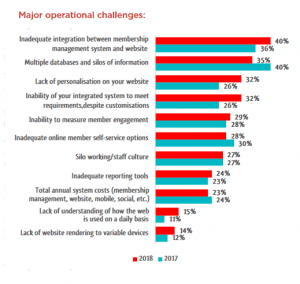Andrew Vance, Commercial Director
Undergoing digital transformation is a huge undertaking for any membership organisation. Adaptations are required at every level to truly realise the benefit of consolidated systems. However, with a documented average ROI of 17% according to a recent Avanade report, digitalisation is an investment that can truly reap benefits.
The Drivers for Digital Transformation
In 2019, some of the biggest operational challenges listed by membership organisations were inadequate digital integrations, fragmented systems and silos of information, indicating a clear case for prioritising technology in 2020.
 Where the operational drivers for digital transformation may be clear, there is no technical approach which provides a true ‘best fit for all’. No matter which end of the development spectrum you find yourself at, the first thing to prepare for is some level of compromise. Whether it’s price, time, flexibility, customisability or integration, be prepared to adapt your approach for the best fit, not the perfect fit.
Where the operational drivers for digital transformation may be clear, there is no technical approach which provides a true ‘best fit for all’. No matter which end of the development spectrum you find yourself at, the first thing to prepare for is some level of compromise. Whether it’s price, time, flexibility, customisability or integration, be prepared to adapt your approach for the best fit, not the perfect fit.
1. Bespoke
The idea of building a system from the ground up that considers each of your unique organisational requirements is hugely appealing.
However, given the rate at which technologies change and your organisation evolves, building something that fits ‘precisely’ now may not serve your business in the longer term and will come at a huge cost.
To build a solution with even half of the functionality offered by a market leading CRM software vendor, like Dynamics 365 from Microsoft, would cost millions of pounds.
Aside from the higher price, other considerations include limitations to feature enhancements, less robust testing and an inability to move to new suppliers, with IP and source code often locked down.
2. Customise
When it comes to futureproofing, customisation can provide the best of both worlds. Starting with the foundations of established industry solutions like Umbraco or Kentico, it is possible to adapt and build new features to fit the needs of your organisation.
A common misconception is that customisation and configuration are the same thing. Customisation is different, in that it adapts the source code and the architecture of the base system. These customisations can go far beyond core system functionality and even include fully bespoke bolt on features.
The drawback of this approach comes when excessive customisations have been made. This usually causes the biggest disruption when it comes to making routine updates, where new features can sometimes cause errors in the base system.
3. Configure
As the demand for more flexible software continues to grow, system suppliers are moving towards a more diverse number of configurable features within their solutions. This provides more flexibility, without changing any of the source code.
For example, Member specific functions such as membership renewals can be configured without development within a system like Microsoft Dynamics 365.
4. Off the Shelf SaaS
SaaS (software as a service) solutions, are great if you are happy to compromise on custom or configured features and adopt a set of pre-existing processes and functions. Out of the box, you can quickly tap into an exciting range of features, usually priced based on a manageable monthly licencing fee.
Our advice if opting for a lower cost SaaS solution is to do lots of research before deciding to make sure features fit organisational needs.
Which Technical Approach is best for your Membership organisation?
In our experience, customisation or configuration are most commonly the adopted approaches in the membership sector. Building on the foundation of a proven set of software solutions, for CRM, website and member portals offers rich functionality out of the box, while allowing for adaptations fit for your organisational needs. Find out more in the MemberWise Digital Excellence 2019 report.
Why might this approach be the most effective? Digital transformation is a journey, not a destination. Membership organisations should focus on solutions that can evolve with them over time.
 Wattle are creative technology partners for membership organisations like the Royal Institute of British Architects, the Chartered Institute of Marketing and the Chartered Institute of Arbitrators.
Wattle are creative technology partners for membership organisations like the Royal Institute of British Architects, the Chartered Institute of Marketing and the Chartered Institute of Arbitrators.









Leave A Comment